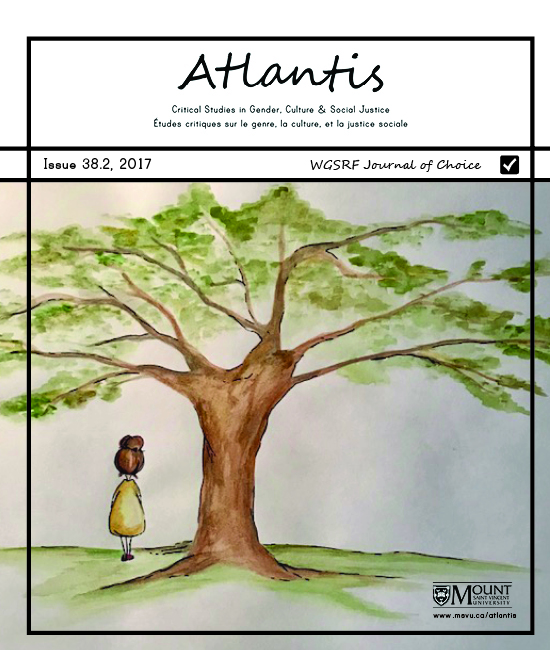Soft Architecture: Walking as an Affective Practice in Lisa Robertson’s “Seven Walks”
Keywords:
Flaneur, Gender representations, Affect, Urban spaceAbstract
Abstract
In Lisa Robertson’s “Seven Walks” the speaker and guide do not simply amble through Vancouver’s material space. Their walks are an affective practice that expresses the city in terms of the fluidity of becoming rather than the fluidity of commodity exchange and suggests that the productivity of sexually differentiated walking is distinct from traditional masculinist discourses of the peripatetic as contemplative or simply transgressive.
Résumé
Dans le livre Seven Walks de Lisa Robertson, la narratrice et la guide ne se contentent pas de déambuler dans l’espace physique de Vancouver. Leurs promenades sont un exercice affectif qui exprime la ville en termes de fluidité du devenir plutôt que de fluidité des échanges commerciaux et suggère que la productivité de la promenade sexuellement différenciée se distingue des discours masculinistes traditionnels du péripatéticien comme contemplatif ou simplement transgressif.
Metrics
References
Ahmed, Sara, and Jackie Stacey. 2001. “Introduction.” In Thinking Through The Skin, edited by Sara Ahmed and Jackie Stacey, 1-17. New York, NY: Routledge.
Braidotti, Rosi. 2002. Metamorphoses: Towards a Materialist Theory of Becoming. Malden, MA: Polity Press.
____. 2006. “The Ethics of Becoming-Imperceptible.” In Deleuze and Philosophy, edited by Constantin V. Boundas, 133-159. Edinburgh, UK: Edinburgh University Press.
____. 2011a. Nomadic Subjects: Embodiment and Sexual Difference in Contemporary Feminist Theory. 2nd ed. New York, NY: Columbia University Press.
____. 2011b. Nomadic Theory: The Portable Rosi Braidotti. New York, NY: Columbia University Press.
De Landa, Manuel. 1999. “Deleuze, Diagrams and the Open-Ended Becoming of the World.” In Becomings: Explorations in Time, Memory, and Futures, edited by Elizabeth Grosz, 29-41. Ithaca, NY: Cornell University Press.
D’Souza, Aruna, and Tom McDonough. 2006. “Introduction.” In The Invisible Flâneuse: Gender, Public Space and Visual Culture in Nineteenth-Century Paris, edited by Aruna D’Souza and Tom McDonough, 1-17. Manchester, UK: Manchester University Press.
Grosz, Elizabeth. 1999. “Thinking the New: Of Futures Yet Unthought.” In Becomings: Explorations in Time, Memory, and Futures, edited by Elizabeth Grosz, 15-28. Ithaca, NY: Cornell University Press.
_____. 2001. “Architectures of Excess.” In Architecture from the Outside: Essays on Virtual and Real Space, edited by Elizabeth Grosz, 151-166. Cambridge, MA: MIT Press.
Heddon, Deirdre, and Cathy Turner. 2012. “Walking Women: Shifting the Tales and Scales of Mobility.” Contemporary Theatre Review 22 (2): 224-236.
Koolhaas, Rem. 1995. “What Ever Happened to Urbanism?” Design Quarterly 164: 28-31.
Massey, Doreen. 1994. Space, Place and Gender. Malden, MA: Polity Press.
Massumi, Brian. 2002. Parables for the Virtual: Movement, Affect, Sensation. Durham, NC: Duke University Press.
McDowell, Linda. 1999. Gender, Identity and Place: Understanding Feminist Geographies. Minneapolis, MN: University of Minnesota Press.
Robertson, Lisa. 2011. Occasional Work and Seven Walks from the Office for Soft Architecture. 3rd ed. Toronto, ON: Coach House Press.
Robertson, Lisa and Steve McCaffery. 2000. “Philly Talks #17.” Pennsound Center for Programs in Contemporary Writing, 21-38. https://media.sas.upenn.edu/pennsound/groups/phillytalks/pdfs/pt17.pdf
Rose, Gillian. 1993. Feminism and Geography: The Limits of Geographical Knowledge. Minneapolis, MN: University of Minnesota Press.
Thrift, Nigel. 2004. “Intensities of Feeling: Towards a Spatial Politics of Affect.” Geografiska Annaler, Series B, Human Geography 86 (1): 57-78.
Wilson, Elizabeth. 1992. “The Invisible Flâneur.” New Left Review 191: 90-110.
Wolff, Janet. 1985. “The Invisible Flâneuse: Women and the Literature of Modernity.” Theory, Culture & Society 2 (3): 37-46.
Downloads
Published
Issue
Section
License
Authors who publish with this journal agree to the following terms:
1. Authors retain copyright and grant the journal right of first publication, with the work simultaneously licensed under a Creative Commons Attribution 4.0 International License that allows others to share the work with an acknowledgement of the work's authorship and initial publication in this journal.
2. Authors are aware that articles published in Atlantis are indexed and made available through various scholarly and professional search tools, including but not limited to Erudit.
3. Authors are able to enter into separate, additional contractual arrangements for the non-exclusive distribution of the journal's published version of the work (e.g., post it to an institutional repository or publish it in a book), with an acknowledgement of its initial publication in this journal.
4. Authors are permitted and encouraged to preprint their work, that is, post their work online (e.g., in institutional repositories or on their website) prior to and during the submission process. This can lead to productive exchanges, as well as earlier and greater citation of published work. Read more on preprints here.






